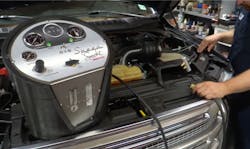Vehicles affected: All
Tools Used:
- Cordless power tools
- Ratcheting box wrench set
- Vehicle diagnostic information
- Diagnostic scan tool
- Shop management system
- Alignment machine
- ADAS calibration equipment
- Remote diagnostic services
- Battery-charging system tester
- Combination high-low pressure diagnostic smoke tester
One dollar and sixty-seven cents. I want you to remember that dollar amount. I’ll explain its significance later.
If 2020 has taught us anything, it must be that we can’t take anything for granted. We should also be able to quickly adapt when faced with adversity. Making sure your shop is operating efficiently is probably the best way to assure that your business can survive almost anything that comes your way. In this month’s Tool Briefing, we’ll discuss a few tools and offer some insight on how to determine if a tool is right for your shop.
One of the first things you’ll need to do is determine just how productive your shop and technicians are. There are many ways to calculate this, but we’ll lay out one of the simplest to cover a variety of situations.
To determine your shop’s productivity, count the hours you’re open during the month, then multiply that by the number of bays you have. For example, if you’re open for 22 days per month and 8 hours per day, you’ll have 176 billable hours per bay. If there are three bays, then you’ll have a total of 528 available hours. If you’re currently billing out 400 hours per month, your shop is working at just above 75 percent productivity.
Understanding your current productivity level is important because when you’re trying to determine if a tool or piece of equipment may be useful, you need to establish how much a tool may improve things. When you look at tool purchases to improve efficiency or productivity, you should break down potential benefits across both technician and individual shop tools.
Technician tools
Improving tool quantity or quality or training a technician to use equipment is one of the least expensive ways to improve productivity. As a bonus, it can also improve loyalty and morale. More productive technicians can bill more hours, improving your bottom line. One of the main objections I have heard from other shop owners in doing this is that the technician could leave and go to a different shop.
If you provide an environment where your technicians can be successful and productive, they won’t look for work elsewhere. Why not take advantage of their enhanced productivity while they’re with you?
Another possible consideration is if you were looking to hire an entry-level technician, they would need to purchase a set of tools to be hired. If your shop were to purchase a starter set of tools for their use, it would allow a young technician to get a head start into this industry without a huge financial investment up front which in many cases would allow many promising young people to enter the workforce. You might even consider giving this tool set to a technician after they have worked for you for a specified amount of time.
Some of the hand tools I’ve found that dramatically increase technician productivity include cordless battery/electric power tools, cordless task lighting, and ratcheting box wrenches. These tools can greatly speed up job completion, thereby freeing up the technician to bill more hours.
One other consideration to improve technician expediency is to examine the jobs they aren’t proficient at. If a new tool or some training can help them improve their efficacy, it could be worth an investment in them to fund their need.
Something I’ve noticed about efficient shops is that there is often a database for vehicle information. That works great if every technician is comfortable and proficient with that system. You might consider obtaining multiple data sources that meet your technicians experience to improve their productivity. If you look at the ROI, you’d only need to improve a single technician’s productivity by an hour or two per month to pay for an additional information resource.
Shop tools
Of course, major equipment purchases such as lifts, air compressors, alignment machines, and other such machinery that improves overall productivity should be purchased by the shop. Understanding when and how to implement those large equipment purchases will necessitate an in-depth look at the ROI far beyond just the purchase price of the equipment. Some factors that affect ROI include the cost of training, determining how many jobs can be performed, what additional work the shop can gain, and what work might need to be sacrificed when new equipment is being used. We can delve into these ROI calculations in a future article.
The shop must look at a tool or equipment purchase through by answering a few questions:
- Will this tool save time and free up technician resources to produce more work?
- Will this tool create a new profit center?
- Will an upgrade of a current tool I own create either of the above goals?
Let’s discuss each of these. For example, a new scan tool may free up a technician for more work if it scans and provides results quicker. Keep in mind there may be a steep learning curve with a new scan tool. You shouldn’t expect your technicians to be proficient with new tools right away.
A new lift that’s both easier to set up with quicker rise and lower times frees up minutes that become hours over a month’s time. If your shop uses a large amount of compressed air, a rotary compressor with line drops at each workstation can dramatically improve technician performance.
Undoubtably, the best way to both track and improve productivity is a comprehensive shop management system that incorporates all essential time-saving tasks into one platform. These time savers include vehicle repair information, parts ordering, vehicle inspection, repair order generation, and reporting. As we mentioned above, multiple repair information resources may be beneficial, but a comprehensive shop management system is worth every penny. Vehicle inspections alone show a consistent increase in repair order values of around $100, as well as better customer service reviews.
To create a new profit center, a tool must expand your service potential into a new arena. For example, if you were to purchase an alignment machine, it should not only add alignment jobs, but if used properly create new profit centers by finding other potential repairs. This might include a steering and suspension component replacement, one of the highest profit margin repairs that can be done. If you were to include ADAS calibration along with the alignment system, you’d then have the ability to perform another highly sought-after service.
Due to the complexity of many repairs and the expense of obtaining factory level tools, an emerging trend of Do it for Me (DIFM) businesses are assisting many shops in diagnosing and repairing vehicles. These services provide a tool that is connected to the vehicle in your shop and allows the remote technician to diagnose or reprogram the vehicle to repair it quickly and correctly. These services’ growth can be very helpful to a shop, mainly because it frees up time for your technician to be productive on other jobs while the remote technician is performing a time-consuming diagnosis. During all this, you’re still free to charge your customer.
When you’re considering upgrading your existing equipment you should consider if the new tool is an upgrade that will either speed up the job, or have the capability to perform tasks that you don’t currently have the ability to do.
An example of this would be a battery/charging system tester. There are many new types of automotive batteries and charging systems that require different test equipment. By upgrading your existing tools, you’d have the ability to work on these systems and, in many cases, perform the job faster.
One of the most effective examples I’ve come across recently that upgrades an existing tool is replacing your low-pressure diagnostic smoke machine, which you use to check for evap and vacuum leaks, with a combination high-and low-pressure tester. These combination machines allow you to continue testing for low-pressure leaks, but also add the capability to diagnose high pressure leaks on boosted vehicles, which is a major cause of drivability problems on turbo and supercharged vehicles. This is a high growth segment of new vehicles purchased, thereby creating a completely new profit center.
One dollar and sixty-seven cents
That’s what you’ll earn for every minute of each technician’s improvement in productivity in your shop. That number is based on a billing rate of $100 per hour and is for each technician, meaning if you have three technicians and you increase each of their productivity by 30 minutes per day. In a 22-day work month, your gross income will increase by $3,300.
Time is money, and you need to determine how you can manage both you and your employees’ time to provide your shop more billable time. Investing in tools is one of the most effective ways to do so.
About the Author

Barry Hoyland
Barry Hoyland has been in the independent aftermarket for more than 45 years as a technician, technician instructor, shop owner, and shop management consultant. He owned and operated a successful Southern California automotive repair center that offers complete auto care and specialized in emission and diagnostic services for over 28 years. Hoyland also owned a company that modified vehicles to perform as emergency response units and mobile command centers, incorporating high-end electronic components into today’s vehicles. Hoyland has experience with all size and types of vehicles including traditional gas, hybrid electric, alternative fuel, and heavy duty diesel trucks.
Hoyland has provided consulting services for many automotive shops, fleets, and government agencies in order to improve their operational efficiencies.
In addition, he has worked with many NHRA drag racing teams as a crew chief on supercharged alcohol and nitro-methane fueled cars and currently serves as a crew chief on a Top Alcohol Funny Car, a Nostalgia Funny Car, and a Nostalgia Alcohol Dragster
Hoyland holds certifications in ASE: A1, A6, A8, and L1, MACS 609, maintains a California Advanced Emission license, and a CDL with endorsements for double and triple trailers, tankers, and HazMat.
When he is not helping to run a shop in the Pacific Northwest, Hoyland travels across the U.S. as an instructor of technical and shop management courses, many of which he has developed.
